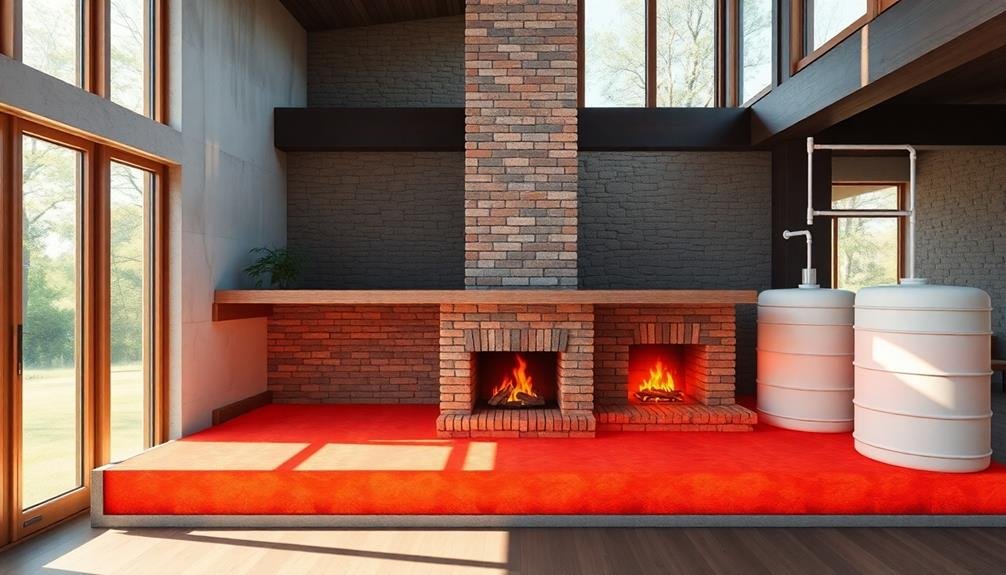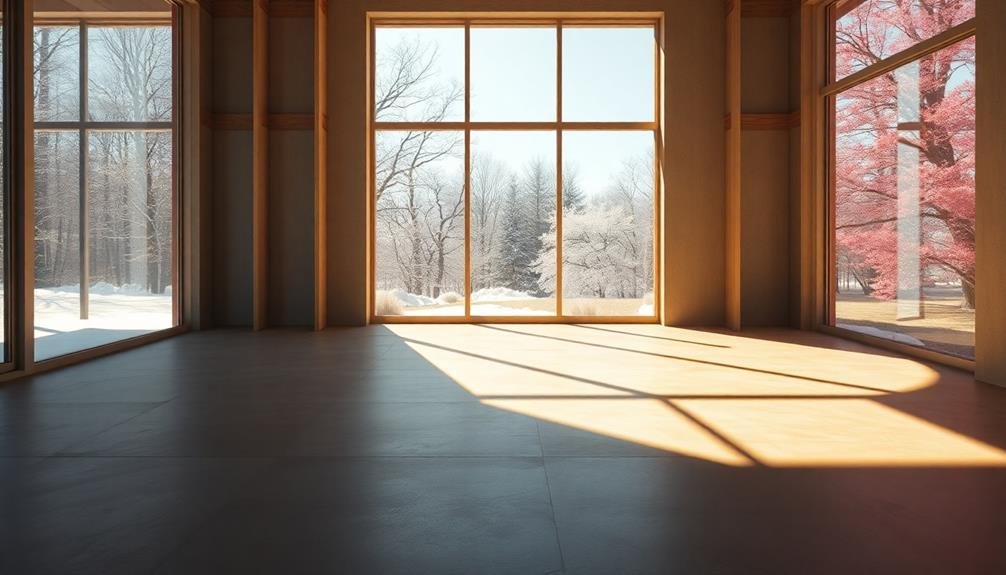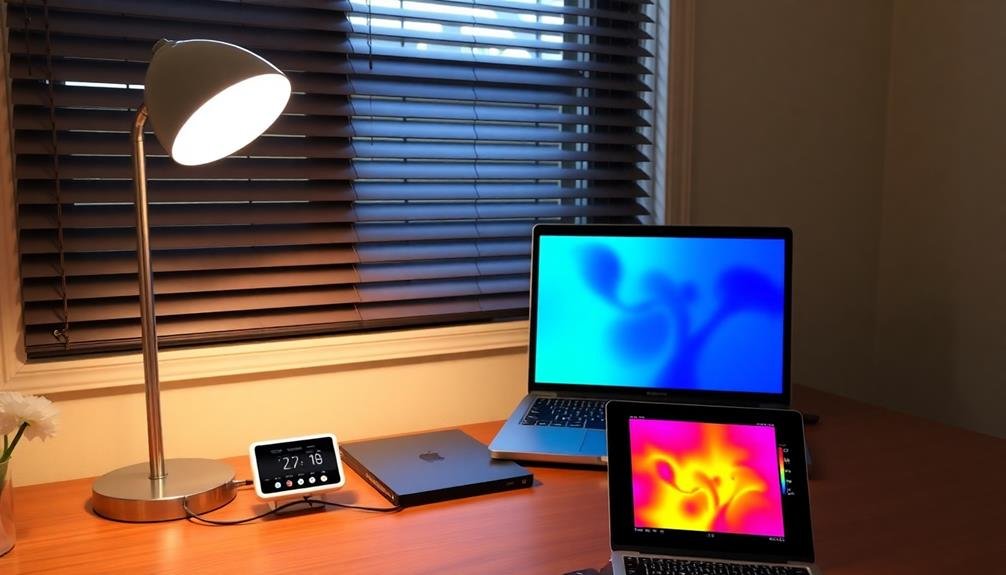Thermal mass is your secret weapon for natural energy efficiency. It's the ability of materials like concrete, brick, and stone to absorb, store, and release heat. By incorporating these dense materials into your home's design, you'll create a natural temperature buffer that stabilizes indoor conditions. This means less reliance on heating and cooling systems, leading to significant energy savings and lower utility bills. Thermal mass works passively, requiring no complex maintenance, and can even improve your home's acoustics. With proper design and strategic placement, you'll harness the power of thermal mass to maximize comfort and minimize energy use. Discover how this simple principle can transform your living space.
Understanding Thermal Mass Principles

Thermal mass, a concept central to energy-efficient building design, plays a crucial role in regulating indoor temperatures. It refers to a material's ability to absorb, store, and release heat over time. You'll find that materials with high thermal mass, like concrete, brick, and stone, can greatly impact your building's energy performance.
When you incorporate thermal mass into your design, you're fundamentally creating a natural temperature buffer. During hot days, these materials absorb excess heat, keeping your indoor spaces cooler. At night, they slowly release this stored heat, maintaining a comfortable temperature without relying heavily on heating systems.
The effectiveness of thermal mass depends on several factors, including the material's density, specific heat capacity, and thermal conductivity. You'll need to reflect on your climate, building orientation, and insulation levels to maximize its benefits.
In hot climates, you might use thermal mass to reduce cooling loads, while in colder regions, it can help store solar heat gains. By understanding these principles, you can strategically place thermal mass elements to create a more energy-efficient and comfortable living environment.
Benefits of Thermal Mass Systems
Harnessing the power of thermal mass systems offers numerous advantages for your building's energy efficiency and comfort.
You'll experience more stable indoor temperatures throughout the day and night, reducing the need for constant heating or cooling adjustments. This stability leads to lower energy consumption and decreased utility bills.
Thermal mass also helps in peak load shifting, allowing you to use energy during off-peak hours when it's cheaper. You'll benefit from improved thermal comfort, as these systems minimize temperature fluctuations and drafts.
In summer, thermal mass absorbs excess heat during the day, keeping your space cooler, while in winter, it stores warmth and releases it gradually.
You'll appreciate the passive nature of thermal mass, which doesn't require complex mechanical systems or ongoing maintenance. It's a sustainable solution that can reduce your carbon footprint and enhance your building's overall energy performance.
Additionally, thermal mass systems can contribute to better acoustics by dampening sound transmission.
Materials for Effective Thermal Mass

When considering materials for effective thermal mass, you'll find high-density building materials at the forefront.
These include concrete, brick, stone, and ceramic tiles, which can absorb and store significant amounts of heat energy.
You might also explore water-based thermal storage systems, as water has an excellent capacity to retain heat and can be integrated into various building designs.
High-Density Building Materials
Selecting the right materials is essential for maximizing thermal mass in buildings. You'll want to focus on high-density materials that can effectively absorb, store, and release heat. These materials work best when they're exposed to direct sunlight or placed in areas with good air circulation.
Common high-density building materials for thermal mass include:
- Concrete
- Brick
- Stone
- Ceramic tiles
- Water (in containers)
Concrete is a popular choice due to its versatility and high thermal mass properties. You can use it in floors, walls, or even as decorative elements.
Brick and stone offer similar benefits and can be incorporated into both interior and exterior designs. Ceramic tiles are excellent for flooring, especially in areas that receive direct sunlight.
Don't overlook the potential of water as a thermal mass material. While it's not a traditional building material, you can incorporate water features or tanks into your design to enhance thermal performance.
When using these materials, remember to reflect on their placement and exposure to maximize their effectiveness in regulating indoor temperatures and reducing energy costs.
Water-Based Thermal Storage
Water stands out as a uniquely effective material for thermal mass due to its exceptional heat capacity. It can store more heat per unit volume than most other materials, making it an excellent choice for thermal storage in buildings. You'll find water-based thermal storage systems in various forms, from simple water tanks to more complex phase-change materials.
When incorporating water-based thermal mass into your home, consider these options:
| Method | Advantages | Considerations |
|---|---|---|
| Water Tanks | High capacity, low cost | Requires space, potential leaks |
| Radiant Floors | Even heat distribution | Installation complexity |
| PCM Panels | Compact, efficient | Higher initial cost |
Water walls are another innovative approach, where large containers of water are placed within your living space. They absorb heat during the day and release it at night, helping to maintain a stable indoor temperature. You can also use water-filled columns or tubes as architectural elements that double as thermal mass. By strategically placing these water-based thermal storage solutions, you'll enhance your home's energy efficiency and reduce reliance on mechanical heating and cooling systems.
Designing With Thermal Mass
Architects and builders face an essential task when incorporating thermal mass into their designs. They must carefully consider the building's location, orientation, and climate to maximize the benefits of thermal mass. You'll want to strategically place thermal mass materials to absorb heat during the day and release it at night, creating a more stable indoor temperature.
When designing with thermal mass, keep these key factors in mind:
- Material selection: Choose dense materials like concrete, brick, or stone
- Placement: Position thermal mass where it can receive direct sunlight
- Insulation: Properly insulate the building envelope to retain stored heat
- Ventilation: Incorporate natural ventilation to manage heat exchange
- Shading: Use shading devices to control solar gain during hot seasons
You should also consider the building's intended use and occupancy patterns. For residential structures, focus on placing thermal mass in living areas and bedrooms.
In commercial buildings, prioritize high-traffic zones and spaces with consistent occupancy. By integrating thermal mass effectively, you'll create a more energy-efficient and comfortable environment that reduces reliance on mechanical heating and cooling systems.
Remember to balance thermal mass with other passive design strategies for ideal performance.
Seasonal Considerations for Thermal Mass

As the seasons change, so too should your approach to utilizing thermal mass in buildings.
In summer, you'll want to shield thermal mass from direct sunlight to prevent overheating. Use shading devices, overhangs, or deciduous trees to block the sun's rays during peak hours. At night, open windows to allow cool air to circulate and recharge the thermal mass.
During winter, expose thermal mass to direct sunlight wherever possible. South-facing windows can help capture solar heat, which is then absorbed and slowly released by the thermal mass. Insulate exterior walls to prevent heat loss and maximize the benefits of the stored warmth.
In spring and fall, be prepared to adjust your strategy more frequently. These shifting seasons often require a combination of summer and winter techniques. Pay attention to daily temperature fluctuations and adapt accordingly. You might need to shade thermal mass on warmer days but expose it on cooler ones.
Remember that thermal mass works best when combined with proper insulation and ventilation.
Combining Thermal Mass With Insulation
While thermal mass plays a key role in energy efficiency, it's most effective when paired with proper insulation.
When you combine these two elements, you create a powerful system for regulating indoor temperatures and reducing energy consumption. Thermal mass absorbs and stores heat, while insulation slows down heat transfer between the interior and exterior of your home.
To maximize the benefits of thermal mass and insulation, consider the following:
- Place insulation on the exterior side of thermal mass walls
- Use high-quality insulation materials with appropriate R-values
- Guarantee proper air sealing to prevent heat loss through gaps
- Incorporate insulated windows and doors to complement thermal mass
- Balance the amount of thermal mass with insulation levels for peak performance
Cost-Effectiveness of Thermal Mass Solutions

When considering thermal mass solutions, you'll need to weigh the initial investment against long-term savings potential.
While upfront costs for materials like concrete or stone can be significant, you're likely to see substantial energy savings over time.
Your payback period will depend on factors such as climate, building design, and energy prices, but many homeowners find thermal mass solutions become cost-effective within a few years.
Long-Term Savings Potential
The long-term savings potential of thermal mass solutions can be substantial. When you invest in thermal mass features for your home or building, you're setting yourself up for significant energy savings over time. These solutions help regulate indoor temperatures, reducing the need for heating and cooling systems to work overtime.
Here are some key factors contributing to long-term savings:
- Lower energy bills due to reduced HVAC usage
- Decreased maintenance costs for heating and cooling systems
- Potential incentives or tax breaks for energy-efficient upgrades
- Increased property value from improved energy performance
- Extended lifespan of HVAC equipment due to less frequent use
As energy prices continue to rise, the savings you'll enjoy from thermal mass solutions will likely increase. You'll find that the initial investment pays for itself through reduced utility costs and improved comfort.
Additionally, you won't need to replace your HVAC systems as frequently, saving on equipment costs. By incorporating thermal mass into your building design or renovations, you're making a smart financial decision that'll benefit you for years to come.
Initial Investment Versus Payback
Weighing up the initial investment against the long-term payback is essential when considering thermal mass solutions.
You'll need to factor in the upfront costs of materials and installation, which can be higher than traditional building methods. However, the energy savings over time can offset this initial expense.
The payback period for thermal mass investments varies depending on your climate, energy prices, and specific design. In moderate climates, you might see returns within 5-10 years, while in extreme climates, it could be shorter.
Remember, thermal mass isn't just about energy savings; it also enhances comfort and reduces temperature fluctuations.
To assess cost-effectiveness, consider:
- Energy bill reductions
- Potential increases in property value
- Reduced HVAC system size and maintenance
- Longevity of thermal mass materials
It's vital to work with experienced professionals who can accurately model your building's performance and provide realistic payback estimates.
While the upfront costs may seem overwhelming, the long-term benefits of thermal mass often make it a wise investment for energy-conscious homeowners and businesses.
Maintenance and Longevity of Systems
Maintaining thermal mass systems properly guarantees their longevity and excellent performance.
You'll find that these systems require minimal upkeep compared to active heating and cooling methods. Regular inspections and cleaning are usually sufficient to keep them functioning effectively for decades.
When you invest in thermal mass, you're choosing a long-lasting solution. Most thermal mass materials, like concrete, stone, or brick, can last for 50 to 100 years or more with proper care.
This durability translates to significant cost savings over time, as you won't need frequent replacements or repairs.
To make certain your thermal mass system remains effective, consider these maintenance tips:
- Clean surfaces regularly to maintain heat absorption and radiation efficiency
- Check for and repair any cracks or damage promptly
- Confirm proper ventilation to prevent moisture buildup
- Maintain appropriate shading devices to enhance seasonal performance
- Periodically review and adjust your system's design as your needs change
Frequently Asked Questions
How Does Thermal Mass Affect Indoor Air Quality?
Thermal mass doesn't directly affect indoor air quality. However, it can help stabilize temperatures, reducing the need for HVAC systems. This may indirectly improve air quality by decreasing air circulation and potential pollutant distribution in your home.
Can Thermal Mass Be Retrofitted Into Existing Buildings?
Yes, you can retrofit thermal mass into existing buildings. You'll need to add dense materials like concrete, stone, or water tanks. It's often done by installing thick flooring, interior walls, or even rooftop gardens.
Are There Any Disadvantages or Limitations to Using Thermal Mass?
You'll find some drawbacks to thermal mass. It can make spaces slow to heat up, increase construction costs, and may not be effective in all climates. It's also challenging to retrofit and can limit design flexibility.
How Does Thermal Mass Impact the Acoustic Properties of a Space?
You'll notice that thermal mass affects acoustics. It can absorb sound, reducing echoes and reverberation in a space. However, it may also reflect some frequencies, potentially creating a harder, more resonant environment. Consider this when designing.
What Role Does Thermal Mass Play in Passive Solar Design?
You'll find thermal mass essential in passive solar design. It absorbs heat during the day and releases it at night, regulating indoor temperatures. It's your natural temperature buffer, reducing heating and cooling needs year-round.
In Summary
You've now explored the power of thermal mass for natural energy efficiency. By incorporating these principles into your designs, you'll create more comfortable, sustainable spaces that require less energy to heat and cool. Remember to reflect on your climate, choose appropriate materials, and balance thermal mass with insulation. While initial costs may be higher, you'll reap long-term benefits in energy savings and improved comfort. Embrace thermal mass to create buildings that work harmoniously with nature.





Leave a Reply